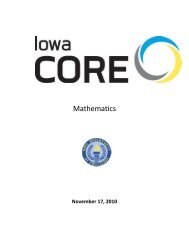The Arc's Self-Determination Scale: Procedural Guidelines
The Arc's Self-Determination Scale: Procedural Guidelines
The Arc's Self-Determination Scale: Procedural Guidelines
You also want an ePaper? Increase the reach of your titles
YUMPU automatically turns print PDFs into web optimized ePapers that Google loves.
preferences and make choices have been linked to reductions in<br />
problem behaviors exhibited by individuals with severe disabilities<br />
(Gardner, Cole, Berry & Nowinski, 1983; Grace, Cowart &<br />
Matson, 1988; Munk & Repp, 1994), increased participation of<br />
children, youth and adults with and without disabilities in<br />
appropriate or adaptive tasks (Koestner, Ryan, Bernieri & Holt,<br />
1984; Swann & Pittman, 1977; Realon, Favell & Lowerre, 1990)<br />
and more positive educational or achievement outcomes (Koenigs,<br />
Fielder & deCharmes, 1977). In short, choice-making is an<br />
effective management strategy as well as a valued skill (Dunlap,<br />
1990).<br />
Kohn (1993) provided another reason to implement strategies<br />
that involve students in choices and decisions in the classroom; it<br />
is beneficial to the teacher. He quotes one educator who stated:<br />
I’ve been teaching for more than 30 years and I would have<br />
been burned out long ago but for the fact that I involve my<br />
kids in designing the curriculum. I’ll say to them, “What’s<br />
the most exciting way we could study this next unit?” If<br />
we decide their first suggestion isn’t feasible, I’ll say,<br />
“Okay, what’s the next most exciting way we could study<br />
this?” <strong>The</strong>y always come up with good proposals, they’re<br />
motivated because I’m using their ideas, and I never do the<br />
unit in the same way twice (Kohn, 1993, p. 12).<br />
Shevin and Klein (1984) suggested that there were three<br />
essential components to a choice-fostering curriculum; (a)<br />
cognitive/discrimination skills cluster; (b) affective skills cluster;<br />
and (c) generalization of skills in real-life experiences. Under the<br />
first of these clusters, Shevin and Klein identified “those skills<br />
which enable the learner to understand and discriminate from<br />
among alternatives as a prerequisite to acting.” <strong>The</strong>y included in<br />
this cluster skills like visual, auditory, and tactile discrimination,<br />
and an understanding of concepts like “choose” and “more.”<br />
Affective skills in the second cluster involve student identifications<br />
of likes, dislikes, interests, abilities, wants, needs and, ultimately,<br />
preferences.<br />
<strong>The</strong> skills identified in these first two clusters represent<br />
instructional opportunities for early childhood and elementary<br />
school years. Shevin and Klein (1984), along with others,<br />
emphasized the importance of learning such skills in contexts that<br />
promote generalization and provide real life opportunities to<br />
experience choices. <strong>The</strong>y also stressed integrating choice-making<br />
opportunities throughout the school day and listed five keys to<br />
maintaining a balance between student choice and professional<br />
responsibility:<br />
28
















